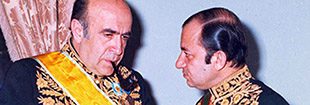Mahmoud Farshchian was born on February 22, 1929, in the historic city of Isfahan, a cultural jewel of Iran renowned for its architecture, calligraphy, and arts. The environment of his childhood was steeped in the visual beauty of Safavid architecture, intricate tilework, and the rhythms of traditional craftsmanship. His father, an Isfahan carpet dealer, played a decisive role in nurturing his artistic inclinations. Carpets, with their elaborate designs and deep symbolism, are themselves a visual art form; growing up in a home filled with these patterns undoubtedly sensitized young Mahmoud to color, line, and composition.
Recognizing his son’s artistic potential, Farshchian’s father introduced him to Mirza Agha Emami, a master painter of the time. Emami immediately recognized the young boy’s exceptional talent and agreed to mentor him. This early apprenticeship introduced Farshchian to the fundamentals of drawing, brushwork, and the meticulous discipline required in the world of fine arts. Later, he studied under another influential teacher, Isa Bahadori, at the Isfahan School of Fine Arts. Bahadori was himself an important figure in Iranian painting, and his guidance reinforced Farshchian’s technical skills while deepening his appreciation for Persian artistic traditions.

